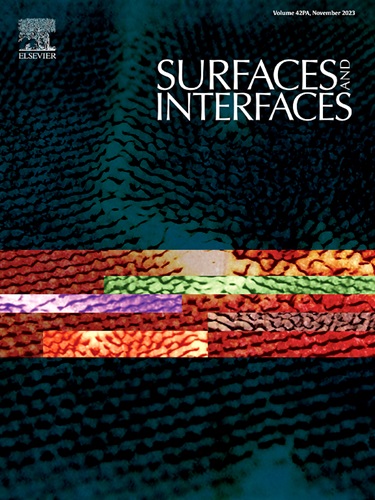增强 K0.67[Ni0.3Mn0.6Co0.1] O2 作为二次钾离子电池阴极材料的电化学性能:改善钾离子插入和降低电荷转移障碍
IF 5.7
2区 材料科学
Q2 CHEMISTRY, PHYSICAL
引用次数: 0
摘要
钾离子电池具有工作电压高、成本效益高的特点,是大规模储能系统的有力竞争者。然而,要实现高容量和高倍率,正极面临着巨大挑战,这阻碍了其实际应用。本文通过固态(S-KNMCO)和共沉淀(C-KNMCO)路线合成了一种新型层状氧化物阴极--K0.67[Ni0.3Mn0.6Co0.1] O2(KNMCO)。KNMCO 的 X 射线衍射(XRD)峰被确定为 R3 m 空间群,并与六方晶胞呈良好的指数关系。FE-SEM 显示了两种样品的非球形形态。此外,合成阴极材料的高分辨率透射电子显微镜(HR-TEM)图像显示,S-KNMCO 的层间距大于 C-KNMCO。此外,以 K 金属为阳极,电解质 KPF6 为 EC/DEC(1:1,v/v),对 S-KNMCO 和 C-KNMCO 的电化学性能进行了表征。在电流速率为 C/20 时,S-KNMCO 和 C-KNMCO 的最大比放电容量分别为 ∼101 mAhg-1 和 ∼66 mAhg-1。此外,这些电池还显示出良好的速率能力和库仑效率(94%)。这项研究为开发 KIB 的阴极物质提供了新的视角。本文章由计算机程序翻译,如有差异,请以英文原文为准。
![Enhanced electrochemical performance of K0.67[Ni0.3Mn0.6Co0.1] O2 as a cathode material for secondary K-Ion batteries: Improved K-Ion insertion and reduced charge transfer barrier](https://img.booksci.cn/booksciimg/2024-10/99294511491760082271.jpg)
Enhanced electrochemical performance of K0.67[Ni0.3Mn0.6Co0.1] O2 as a cathode material for secondary K-Ion batteries: Improved K-Ion insertion and reduced charge transfer barrier
Potassium-ion batteries, with their high operating voltage and cost-efficiency, emerged as promising contenders for large-scale energy storage system. Nevertheless, the practical application is hindered by the significant challenges of achieving high capacity and good rate capability in cathodes. Herein, a novel layered oxide cathode, K0.67[Ni0.3Mn0.6Co0.1] O2 (KNMCO), has been synthesized via solid-state (S-KNMCO) and co-precipitation (C-KNMCO) routes. The X-Ray diffraction (XRD) peaks of KNMCO are identified in R3 m space group and well-indexed to hexagonal unit cell. The FE-SEM shows non-spherical morphologies for both samples. Additionally, high-resolution transmission electron microscopy (HR-TEM) images of the synthesized cathode materials shows the interlayer spacing of S-KNMCO is higher than that of C-KNMCO. Furthermore, the electrochemical performance of S-KNMCO and C-KNMCO is characterized using K-metal as anode and electrolyte KPF6 in EC/DEC (1:1, v/v). The S-KNMCO and C-KNMCO exhibit the maximum specific discharge capacity of ∼101 mAhg-1 and ∼66 mAhg-1 at the current rate of C/20 respectively. Additionally, these cells show the good rate capability and coulombic efficiency (∼94%). This research offers novel perspectives on the development of cathode substances for KIBs.
求助全文
通过发布文献求助,成功后即可免费获取论文全文。
去求助
来源期刊

Surfaces and Interfaces
Chemistry-General Chemistry
CiteScore
8.50
自引率
6.50%
发文量
753
审稿时长
35 days
期刊介绍:
The aim of the journal is to provide a respectful outlet for ''sound science'' papers in all research areas on surfaces and interfaces. We define sound science papers as papers that describe new and well-executed research, but that do not necessarily provide brand new insights or are merely a description of research results.
Surfaces and Interfaces publishes research papers in all fields of surface science which may not always find the right home on first submission to our Elsevier sister journals (Applied Surface, Surface and Coatings Technology, Thin Solid Films)
 求助内容:
求助内容: 应助结果提醒方式:
应助结果提醒方式:


